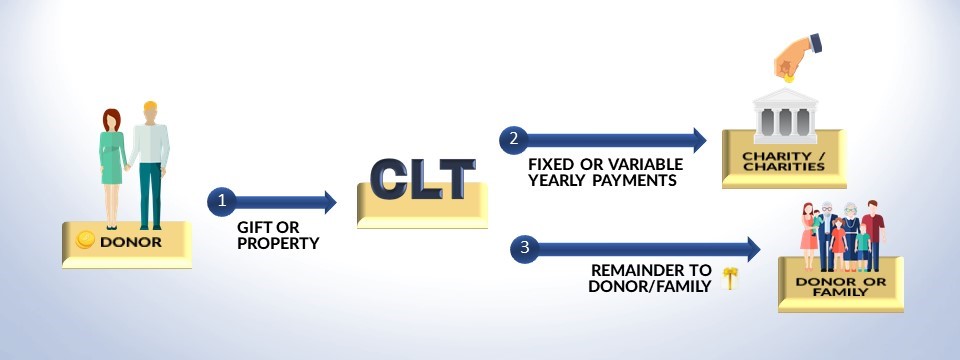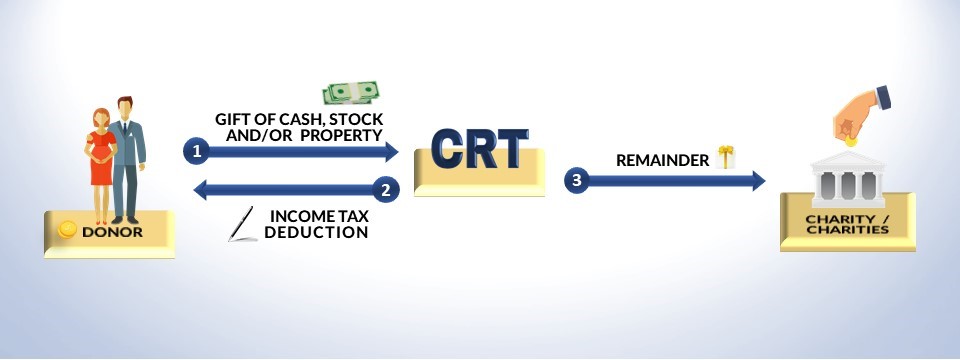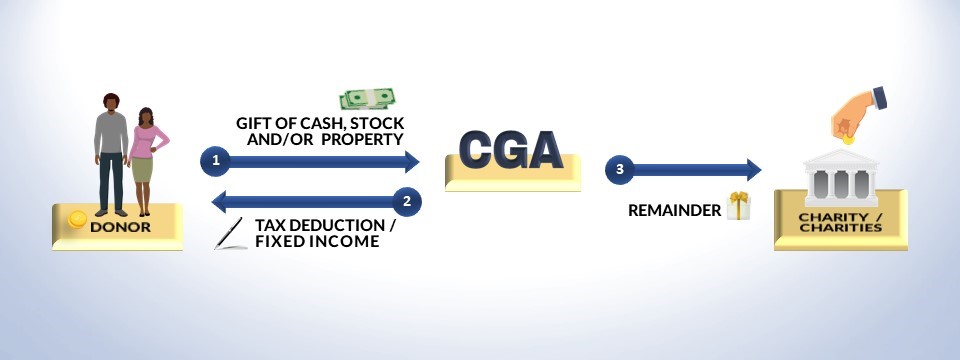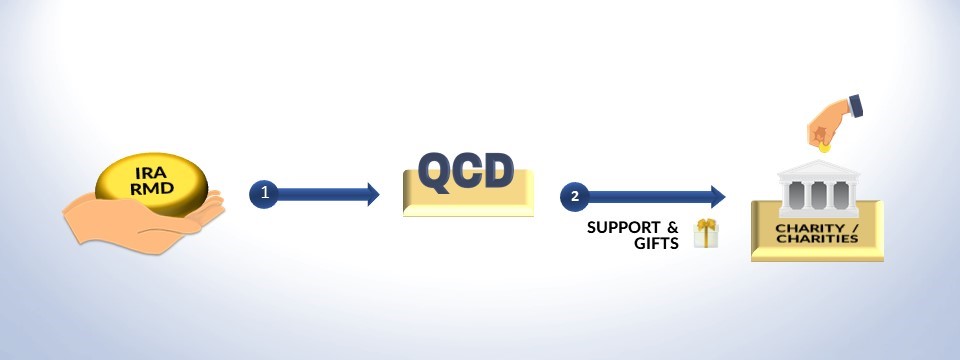5 Charitable Planning Options That Can Save You Money on Taxes
Due to recent changes in the tax law, charitable planning is becoming an intricate part of tax, estate and gift planning. It's important to plan now while opportunities still exist.


Since the 2017 Tax Cuts and Jobs Act, now more than ever there is a greater incentive for donors to contemplate whether charitable planning will provide an immediate or future benefit. Donors who will benefit from this range from business owners, executives, doctors, accountants, attorneys, professional athletes and even retirees due to the new deduction limits on state and local taxes (SALT), the elimination of several other deductions, as well as the increased standard deduction.
Here are five charitable planning options that can save you money on taxes in 2019 and beyond:
1. Donor-Advised Fund (DAF)
A donor-advised fund is a separately managed charitable investment account that is operated by a section 501(c)(3) organization, also known as a sponsor or sponsoring organization. You can contribute cash, appreciated securities, real estate and other property to receive an immediate tax deduction. Those assets grow tax-free, and in turn you can make recommendations to any charity, although the sponsoring organization makes the final decision (learn more by reading Choosing Between a Private Foundation vs. Donor-Advised Fund).
From just $107.88 $24.99 for Kiplinger Personal Finance
Become a smarter, better informed investor. Subscribe from just $107.88 $24.99, plus get up to 4 Special Issues

Sign up for Kiplinger’s Free Newsletters
Profit and prosper with the best of expert advice on investing, taxes, retirement, personal finance and more - straight to your e-mail.
Profit and prosper with the best of expert advice - straight to your e-mail.
The main advantage of a donor-advised fund is an upfront tax deduction. The disadvantages are loss of control with contributions, investment fees charged, and the sponsoring organization having the final choice on the charity that receives the funds.

2. Charitable Lead Trust (CLT)
A charitable lead trust is a type of irrevocable trust that provides income payments to a charity for a period of time — typically through a fixed term of years — with the remainder either going to the donor or donor’s family members. Gifts can be cash, appreciated securities, real estate and other types of property. Depending on the type of charitable lead trust — grantor or non-grantor — the purpose for establishing either can be for estate or gift tax reduction, as well as an income tax deduction.
A grantor charitable lead trust makes payments to a charity for a fixed period of years, with the remainder going back to the donor (also known as the “grantor”). With this structure, the donor, or grantor, would receive an upfront income tax deduction for the present value of the charitable donation. However, the donor would not receive any additional tax deductions for future distributions made to a charity or charities through the rest of the term.
A non-grantor charitable lead trust makes payments to a charity for a fixed period of years, with the remainder going to family members or other persons who are not the donor. With this structure, the donor can substantially — or potentially entirely — avoid paying estate or gift taxes.
The advantages to the donor are either an upfront tax deduction or estate or gift tax reduction. In addition, the charity will also instantly benefit the most from this arrangement because of the immediate payments that will be made. The disadvantage is that once assets are transferred to the trust, they cannot be removed.

3. Charitable Remainder Trust (CRT)
A charitable remainder trust is another type of irrevocable trust, and the complete opposite of a charitable lead trust. Assets are transferred to the charitable remainder trust, which gives an immediate tax deduction, in addition to income for a period of time or the rest of your life. Gifts can be cash, appreciated securities, real estate and other types of property.
The income stream can be paid to you, a spouse, and any leftover will go to a beneficiary if you were to pass away prematurely and didn’t receive the predetermined income payments. At death, the remainder goes to the charity of your choice.
The advantages to the donor are the upfront tax deduction as well as the income payments made. Keep in mind that with this structure a charity will only benefit from this arrangement after you pass away. As with a charitable lead trust, the disadvantage is that once assets are transferred to the trust, they cannot be removed.

4. Charitable Gift Annuity (CGA)
A charitable gift annuity is an irrevocable contract between a donor and a charity that provides an upfront tax deduction as well as a lifetime stream of income payments. Gifts can be cash, appreciated securities, real estate and other types of property (learn more by reading Gift Annuity Offers Tax Break and Retirement Income).
Many nonprofits and large universities offer charitable gift annuities. The advantages to the donor are the upfront tax deduction as well as the income payments. Similar to a charitable remainder trust, the charity (or multiple charities) will only benefit from this arrangement after you pass away. The disadvantages are that once assets are transferred to the trust, they cannot be removed and payments will cease if the charity goes insolvent.
As you can see, the charitable remainder trust and charitable gift annuity are very similar. The differences lie in their structure. Charitable gift annuities — like all annuities — are contracts and pay you (and your spouse if structured correctly) fixed payments for the rest of your lives, not adjusted for inflation. Payments are backed by the charity’s assets and are more regulated than a charitable remainder trust. With a charitable remainder trust, you can choose from either fixed or variable payments with both the tax deduction and payout potentially greater versus the charitable gift annuity. Also, the charitable remainder trust has more flexibility in case you want to contribute appreciated assets.

5. Qualified Charitable Distribution (QCD)
A qualified charitable distribution is for those age 70½ or more who don’t want (or need) the required minimum distribution (RMD) from their IRA. Although a QCD doesn’t provide an upfront tax deduction or lifetime income like a charitable gift annuity or trust would, it’s an overlooked tax loophole because retirees can exclude up to $100,000 per year from their RMDs without having to claim it on their tax return. The QCD is made directly from your IRA to a charity without having to be claimed as income. If you’re married, your spouse can also exclude up to $100,000 per year as well.
The advantage to the donor is the exclusion of up to $100,000 per year from their tax return (each spouse), which can help reduce Social Security taxation as well as Medicare premiums due to the lower adjusted gross income (AGI). The disadvantage is once the RMD is transferred to a charity, it is irrevocable and cannot be undone.

While it’s vital to have this conversation with a well-versed tax or financial professional, donors should explore certain charitable vehicles (or a combination) to maximize their tax deductions now while supporting a favorite charity at the same time. Otherwise, these opportunities may cease or substantially change in the next few years.
Profit and prosper with the best of Kiplinger's advice on investing, taxes, retirement, personal finance and much more. Delivered daily. Enter your email in the box and click Sign Me Up.

Carlos Dias Jr. is a financial adviser, public speaker and president of Dias Wealth, LLC, headquartered in the Orlando, Fla., area, but working with clients nationwide. His expertise spans a diverse clientele, including business owners, retirees, lottery winners and professional athletes with wealth management, tax planning, estate planning, long-term care, annuities and life insurance. Carlos has contributed to Kiplinger, Forbes and MarketWatch, and his work has been featured in CNN, CNBC, The Wall Street Journal, U.S. News & World Report, USA Today and other publications. He’s spoken at various CPA societies across the United States, and Carlos’ presentations often focus on innovative tax strategies, retirement planning and asset protection, providing valuable knowledge to accountants, attorneys and financial professionals.
-
 Dow Adds 646 Points, Hits New Highs: Stock Market Today
Dow Adds 646 Points, Hits New Highs: Stock Market TodayIt was "boom" for the Dow but "bust" for the Nasdaq following a December Fed meeting that was less hawkish than expected.
-
 5 Types of Gifts the IRS Won’t Tax: Even If They’re Big
5 Types of Gifts the IRS Won’t Tax: Even If They’re BigGift Tax Several categories of gifts don’t count toward annual gift tax limits. Here's what you need to know.
-
 The 'Scrooge' Strategy: How to Turn Your Old Junk Into a Tax Deduction
The 'Scrooge' Strategy: How to Turn Your Old Junk Into a Tax DeductionTax Deductions We break down the IRS rules for non-cash charitable contributions. Plus, here's a handy checklist before you donate to charity this year.
-
 5 Types of Gifts the IRS Won’t Tax: Even If They’re Big
5 Types of Gifts the IRS Won’t Tax: Even If They’re BigGift Tax Several categories of gifts don’t count toward annual gift tax limits. Here's what you need to know.
-
 The 'Scrooge' Strategy: How to Turn Your Old Junk Into a Tax Deduction
The 'Scrooge' Strategy: How to Turn Your Old Junk Into a Tax DeductionTax Deductions We break down the IRS rules for non-cash charitable contributions. Plus, here's a handy checklist before you donate to charity this year.
-
 I'm a Tax Attorney: These Are the Year-End Tax Moves You Can't Afford to Miss
I'm a Tax Attorney: These Are the Year-End Tax Moves You Can't Afford to MissDon't miss out on this prime time to maximize contributions to your retirement accounts, do Roth conversions and capture investment gains.
-
 I'm an Investment Adviser: This Is the Tax Diversification Strategy You Need for Your Retirement Income
I'm an Investment Adviser: This Is the Tax Diversification Strategy You Need for Your Retirement IncomeSpreading savings across three "tax buckets" — pretax, Roth and taxable — can help give retirees the flexibility to control when and how much taxes they pay.
-
 Could an Annuity Be Your Retirement Safety Net? 4 Key Considerations
Could an Annuity Be Your Retirement Safety Net? 4 Key ConsiderationsMore people are considering annuities to achieve tax-deferred growth and guaranteed income, but deciding if they are right for you depends on these key factors.
-
 I'm a Financial Pro: Older Taxpayers Really Won't Want to Miss Out on This Hefty (Temporary) Tax Break
I'm a Financial Pro: Older Taxpayers Really Won't Want to Miss Out on This Hefty (Temporary) Tax BreakIf you're age 65 or older, you can claim a "bonus" tax deduction of up to $6,000 through 2028 that can be stacked on top of other deductions.
-
 Tax Refund Alert: House GOP Predicts 'Average' $1,000 Payouts in 2026
Tax Refund Alert: House GOP Predicts 'Average' $1,000 Payouts in 2026Tax Refunds Here's how the IRS tax refund outlook for 2026 is changing and what steps you can take now to prepare.
-
 New IRS Changes to FSA Contribution Limits for 2026: What to Know
New IRS Changes to FSA Contribution Limits for 2026: What to KnowHealth Care Flexible Spending Accounts have tax advantages worth looking into, especially in light of new IRS changes.